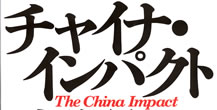
The
China Impact
Cat: ECO
Pub:
2002
#: 0515b
Kenichi Ohmae (大前研一)
05630u/18215r
 |
The China Impact |
Cat: ECO |
Kenichi Ohmae (大前研一) |
05630u/18215r |
Title
The China Impact
チャイナ・インパクト
Published
2002
2002年
Index
- Preface:
- Birth of New China:
- Competitive edges of China:
- Two major Chinese silicon valleys:
- Newly emerging regions:
- North-East provinces:
- Greater China:
- Chinese economy swallows Asia:
- Future of Chinese political system:
- Future of China-Japan relationship:
- Trumps of Japan:
- Choice of Japanese economy:
Why?
- There are lots of report written about Chinese economy from pessimism
to optimism.
- I think "China Impact" of Kenichi Ohmae is one of the
analytical and essential book.
- Objectivity and coolness would be the most important viewpoint
to understand the modern China and Chinese economy.
- China, Korea and Japan have been and will be neighboring countries
since historical ages.
- 中国経済については悲観論から楽観論まで多くのレポートがある。
- 大前研一の"チャイナ・インパクト"は最も分析的で本質を突いた本の一つと思う。
- 現代中国と中国経済を理解するには客観性と冷静さが最も重要な視点であろう。
- 中国と韓国、そして日本は歴史時代を通じて、過去もそしてこれからずっと隣国であり続けるのだから。
>Top 0. Prologue: 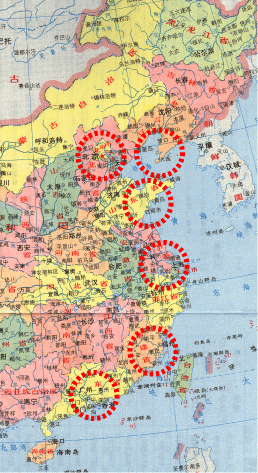
- China, particularly in seacoast provinces, is no more a
sleeping lion.
- The strength of Chinese economy is no doubt due to cheap
and high-qualified labor power with quipped by the latest technology,
backed by more than 1.2 billion population.
- It is obvious that Japanese industry cannot escape from
price competition and has nether hope to win the head-on competition
with China.
- We should consider China not as a single nation, but six maga-regions:
- Three NE provinces,
- Beiching-Tianjin corridor,
- Shandong peninsula,
- Zhangjiang delta,
- Fujian province, and
- Zhujiang delta.
- Present prosperous regions are mostly countries of "Farm-out
economy" (usually called Wimbledon method), while Japan seems
antiforeignis
- Chinese
emerging Six Mega-regions
0.プロローグ:
- 中国、特に沿岸部はもはや眠れる獅子ではない。
- 12億以上の人口を背景に安価で良質な労働力と最新技術の装備によって、中国経済の強さは疑いない。
- 日本の産業は中国との価格競争においても、また正面からぶつかっても勝てないのは明らかである。
- 中国は単一の国家ではなく6つのメガリージョンから成ると見なすべきである。即ち
- 東北三省、
- 北京・天津回廊、
- 山東半島、
- 長江デルタ、
- 福建省、
- 珠江デルタである。
- 現在繁栄している地域はほとんど貸席経済 (ウインブルドン方式とも呼ばれる) である。一方日本は排外主義に見える。
>Top
1. Birth of New China:
- Modern Chinese society is reminiscent of high economic growth
of Japan in 1960s, dawn of the industrial revolution of Britain,
and emerging United States in later half of 19C.
- Big Power:
China has become already a big power for a number of reasons. (as
of 2000)
- Population: 1.27 billion, but this world #1 position will
be soon outstripped by India (1 billion).
- GDP: already 7th, and bigger than Canada.
- Export: Putting together of China 7th and Hong Kong 10th will
close up Japan.
- Economic Growth: China 7.5%, while US 1.3% and EU 1.8%.
- Already #1 market share: Air conditioner, Motor cycle, Electronic
oven, Color TV, Washing machine, Refrigerator, etc.
- Deng Xiaoping's "Speech at the south eyre:
In 1992 Deng Xiao Ping' proclaimed 'One country two systems' policy
and expansion of special economic zone to 32: China will make 30
Singapore's, or a concept of 'United States of China.'
- China pursues staggering growth of various regions (mega-regions),
while Japan pursued homogenous and balanced growth.
- 80th congress of Chinese Communist Party: Jiang Zemin declared
to admit business managers to join CCP, which highlighted drastic
change of CCP itself.
- Zhu Rongji, premier 1998:
was frank, globally intelligent, and stressed merit system, even
called Jack Welch of China. He performed tree promises in three
years:
- Reform of state enterprises:
CEO who causes deficit will be warned in the first year, then
will be fired in the second year. Because only enterprise can
produce wealth. He game CEO freedom of management as well as
responsibility.
- Reform of financial system:
Declared to sweep off bad loans of national banks and trust
companies, and fired more than 50 executives,
- Streamlined administrative structure:
Tried to preserve moral decay of government officials. He decreased
central government officials from 34,000 to 17,000.
- Key words:
There are key words to believe development of China:
- Wealth producing mechanism:
- Federal system:
- Four C's:
All these factors are global: global capital, global corporation,
global consumer, and global communication. In contrast Japan
tends to depend on her own capital, technology, and brain.
- Capital:
- Corporation
- Consumer
- Communication
1.新しい中国の誕生:
- 現代の中国社会は、1960年代の高度成長期の日本、産業革命黎明期の英国、19C後半の勃興する米国を彷彿とさせる。
- 大国:
すでに中国はすでにさまざまな意味で大国になっている。 (2000年段階)
- 人口:12.7億人。但し、この世界一はまもなくインド(10億人)に抜かれる。
- GDP:すでに7位でカナダより大きい。
- 輸出:7位の中国と10位の香港を加えると日本に肉薄。
- 経済成長:中国7.5%、米国1.3%、EU 1.8%
- #1市場シェア:エアコン、オートバイ、電子レンジ、カラーテレビ、洗濯機、冷蔵庫など
- 邓小平の"南巡講話":
1992年に邓小平は'一国二制度'、および経済特区を32まで拡大することを宣言した。これは30のシンガポールができることを意味する。つまり中華連邦という概念である。
- 中国は各地域 (メガリージョン) がそれぞれが先行する成長路線を求めた。一方日本は均等で均衡ある発展を求めた。
- 中国共産党80周年大会:江沢民は企業経営者の共産党入党を認めると宣言。これは中国共産党の質的転換を浮き彫りにした。
- 朱鎔基、首相、1998:
率直、国際的教養があり、実績主義を強調。中国のジャック・ウェルチと呼ばれた。彼は3年間で3つの公約を実行した。
- 国営企業の改革:
赤字を出した社長は、1年目は警告、2年目はクビ。企業のみが富を創出できるからである。社長には経営の自由度と共に責任も与えた。
- 金融システムの改革:
国営銀行および信託会社の不良資産一掃を宣言。50人以上の幹部をクビ。
- 行政組織のスリム化:
行政の腐敗の防止。中央政府の官僚を34,000から17,000人へ
- キーワード:
中国の発展を信じるキーワード。
- 富の創出機構:
- 連邦制:
- 4つのC:
これらの要因はすべてグローバルである。対照的に日本は自前の資金、技術、頭脳に依存する傾向がある。
- キャピタル
- コーポレーション
- コンシューマ
- コミュニケーション
>Top 2. Competitive edges of China:
- Process of quality improvement:
- Japan - step by step:
Rapid yen appreciation in 1985 enforced Japanese export industry
to pursue quality.
- China - leapfrog:
Introduction of latest technology and latest production control
(TQC, or six sigma) from foreign partners. But not yet established
global brand.
- Neusoft Group, Liaoning Sheng: (NEU=North Eastern University)
- Legend: world biggest PC maker
- Little Swan: biggest washing machine maker
- Haier: biggest home electronics maker
- Overseas Chinese (hua qiao):
- mainly from Fujian Sheng
- number: 60 million people
- returnee: 110K out of 320K expatriates (1978-98)
- Communication in China:
- China Telecom:
- China Netcom: created in 2002
- Mobile users (China Mobile, etc): 145M
- Traffic system:
- Shanghai Maglev Train: Dec. 2002 open, 430km/h
- Capital market:
- Singapore, Hong Kong, Xinzhen, Shanghai
- Transaction volume of Xinzhen and Shanghai exceeds Hong Kong
in 2001.
- Laborsaving machinery:
- introduction of Japanese laborsaving machinery (CAD/CAM), which
are developed assuming expensive monthly labor cost around \600-700K
in Japan.
- But China introduced such latest machinery, remaining monthly
labor cost around \10K level.
- Stable currency policy (Renmin Yuan):
In 1997 reversion of Hong Kong, UK agreed to part with $3.8B reserve
to China subject to maintain current status as long as 50 years.
China decided to reserve 13 US$ cents per issuance of HK$1. Thus
HK$ is pegged to US$. When Renmin Yuan is pegged to HK$, Yuan became
fixed in effect to US$. Chinese government abandoned herself to
increase money supply driven by economic distress. This policy rescued
China from Asian currency crisis in 1997.
- In 2000, foreign investment to China amounted about $4.5B, while
$1B invested to Japan.
- Second Shenzhen:
- Expansion of bonded warehouses: at the edge cities like Dongwan,
Zhongshan, Shunde
- Chinese company having its headquarter in Hong Kong is treated
as a foreign capital.
- Adhesion to WTO:
- China became a WTO member in Dec. 2001.
2.中国の競争力:
- 品質向上のプロセス:
- 日本:一歩一歩
1985年の急激な円高は、日本の輸出産業に真剣な品質追求を強いた。
- 中国:一足飛び
外資パートナーから最新技術および生産管理 (TQCやシックスシグマ) を導入。但し、まだグローバルブランドは確立できていない。
- 東軟集団 (遼寧省) 、瀋陽の東北大学と連携
- 連想集団:世界最大のPCメーカ
- 小天鵝集団:最大の洗濯機メーカ
- 海爾集団:最大の家電メー
- 華僑:
- 主に福建省出身者
- 人数:6000万人
- 帰国組:32万の留学生の内11万人が帰国 (1978-98)
- 通信:
- 中国電信集団:
- 中国網絡通信:2002設立
- 携帯電話ユーザ数(中国移動など):1.45億人
- 輸送手段:
- 上海磁浮列車:2002.12開通、430km/h
- 資本市場:
- シンガポール、香港、深セン、上海
- 新セン+上海の取引量は2001年に香港市場を上回る
- 省力装置:
- 日本の省力装置 (CAD/CAM) を導入。これは日本での労働コスト月60-70万円を前提としている。
- しかし中国は、労働コスト月1万円程度でありながら、これら最新鋭の装置を導入。
- 安定通貨政策(人民元):
1997年の香港返還の際、英国は50年間の体制維持を条件に38億ドルの準備金を中国に手渡すことに同意した。中国は香港ドル1に対し米国ドル13セントの積み立てを決定した。これで香港ドルは米国ドルに固定為替となった。人民元は香港ドルに固定為替となると、元は実質的に米国ドルに固定となる。中国政府は経済的苦境によって通貨供給量を増やすことを放棄した。このことが1997のアジア通貨危機から身を守ることになった。
- 2000年には、海外から中国への投資は45億ドルに達した。この間日本への投資は10億ドル。
- 第二深圳:
- 保税区拡大:東莞、中山、順徳のような周辺都市
- 香港に本社を置く中国企業は外資扱い
- WTO加盟:
- 中国は2001年12月にWTOに加盟
>Top 3. Two major Chinese
silicon valleys:
- Zhangjiang delta and Zhujiang delta:
These two regions are the largest industrial zone, introducing
free market economy earlier than other regions.
- Zhangjiang delta: belonged to Shanghai City, Jiangsu Sheng, and
Zhejiang Sheng, shares 20% of Chinese GDP, amounting $230B (2000).
- Semiconductor and mobile industry.
- Financial industry
- Biggest consumer market.
- 28% of world investment to China.
- Zhujiang delta: belonged to Guangdong Sheng, shares 10% of Chinese
GDP, amounting about $115B (2000).
- Return of Hong Kong (1997) and established Shenzhen (1980)
- Contract manufacturing: Labor-intensive like PC assembly
- 28% of world investment to China.
- Features of Zhujiang delta:
- Population 5M: about 100K a decade ago
- Supply Chain Highway:
Highway development by BOT (Build Operation Transfer) (return
to the nation after 17-year private operation):
- Bonded factory:
direct shipment between bonded areas.
- Component factory:
50,000 cluster of companies: (Cf: 8,000 in Ota-ku, Tokyo)
- Home ground of Overseas Chinese:
80% of total Chinese abroad, mostly commercial capitalist, are
from Guangdong Sheng.
- Chinese abroad capital:
shares 50-60%, or more than 80% in a case. But their population
is 1-2% like Thai, Philippines, Indonesia, and Malaysia.
While 80% in Singapore.
- They invested in Australia, Canada, US a decade ago, but
now began to invest in China
- Features of Zhangjiang delta:
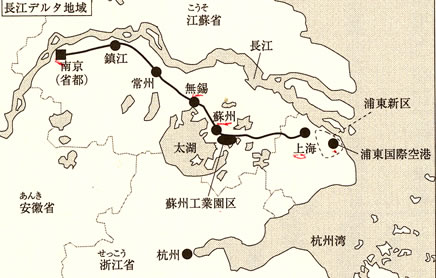
- Hi-tech complex
- Population: about 140M
- Shanghai: 15M habitant; GDP per capita $3,300; active consumer
spending; strategic point of transportation by ports & harbors,
highways, and two international airports, and a distinctive character.
- Pudong area (21C town) vs Namjinglu (19C town)
- Financial center: Shanghai stock exchange consulted by Morgan
Stanley.
- Bonded area: IBM, HP, Motorola, Intel, Siemens, Philips, Sharp,
Hitachi, Kyocera, NEC, etc.
- Shift of headquarter from Hong Kong to Shanghai:
Shanghai is getting to be more like Tokyo.
- Alcatel, HSBC
- Gateway of success as top of CCP:
- Shanghai native: Jiang Zeming, Zhu Rongji, Hu Jintao
- Suzhou:
pivotal point between global market and domestic market.
- One stop service of government permission
3.二大IT産業集積地:
- 長江デルタと珠江デルタ:
これら2地域は、他よりも早く自由市場経済を導入した中国最大の工業地帯である。
- 長江デルタ:上海市、江蘇省、浙江省;中国のGDPの20%、2300億ドル (2000)
- 半導体、携帯産業
- 金融産業
- 最大の消費市場
- 世界の中国への投資額の28%
- 珠江デルタ:広東省、中国GDPの10%、約1150億ドル (2000)
- 香港返還 (1997)、深圳制定 (1980)
- 委託加工 (中国では、来料加工) :PC組立など労働集約産業
- 世界の中国への投資額の28%
-
珠江デルタの特徴:
- サプライチェイン道路:
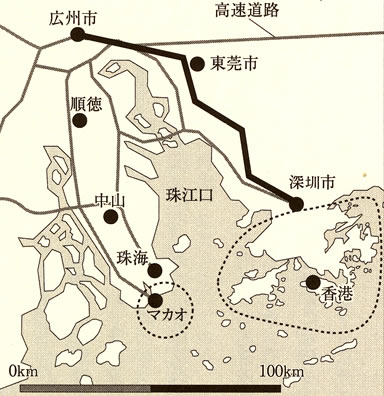
BOT (Build Operation Transfer)方式による高速道路建設 (通行料17年間徴収後、国に返還)
- 保税工場:
保税地域間直送
- 部品工場:
50,000社のクラスター
( : 大田区は8,000社)
- 華僑のホームグランド:
華僑の80% は広東省出身。多くは商業資本
- 華僑資本:
50-60%シェア。場合によっては80%超。但し人口は、タイ、フィリピン、インドネシア、マレーシアでは1-2%。シンガポールは80%
- 10年前は豪州、カナダ、米国に投資
最近は中国へ投資
- 長江デルタの特徴:
- ハイテク工業地帯
- 人口:約1.4億人、一人当たりGDP $3,300、活発な個人消費、交通の要所(港湾・高速道路・2国際空港)、そして風格
- 浦東地区 (21C市街) 対 南京路地区 (!9C市街)
- 金融センター:
上海証券交易所 (モルガンスタンエーがコンサル)
- 保税地区: IBM, HP, Motorola, Intel, Siemens, Philips, シャープ, 日立,
京セラ, NEC等
- 本社を香港から上海へ移転:上海は東京になりつつある。
- Alcatel, 香港上海銀行
- 中国共産党幹部の登竜門:
- 上海出身:江沢民、朱鎔基、胡錦涛
- 蘇州 (苏州):
国際マーケットと国内マーケットとの間の要所
- 政府許可のワンストップサービス
>Top 4. Newly emerging
regions:
 Beijing-Tianjin Corridor:
Beijing-Tianjin Corridor:
- Zhongguancun=Silicon valley in China:
Other megaregions are world factory, but this corridor is getting
world R&D center.
- IBM, MS, Intel, Motorola, Nokia, Matsushita, Fujitsu, etc.
- Beijing University, Qinghua University, Chinese Science Academy
(Kesueyuan), etc.
- Highway between Beijing and Tianjin
- Shandong Peninsula:
- Production base of processed food and frozen food.
- Hq of Haier Electronics
- Production cost of spring (Welsh) onion:
\836 (Shandong Sheng) vs. \4918 (Chiba, Japan)
- Katokichi operates frozen food factories.
- Asahi beer operates oolong tea production.
- Sanyo Foods operates Chinese noodle factory
- Fujian Sheng:
- Fuzhou, capital city, Xiamen (Amoy): mostly mountainous district
- More than 20 big and well-organized ports like Singapore,
and close relationship with SE asia; home country of many overseas
Chinese
- Dell computer in Xiamen.
- Nike operates sneakers production
- "Treble Communications issue": Trade, transportation,
and communication only between Fujian Sheng and Taiwan (Jinmen
& Mazu islands)
- 60M megaregions = Fujian(40M) + Taiwan(20M)
4.発展著しい新興地域:
- 北京・天津回廊:
- 中関村=中国のシリコンバレー:
他地域が世界の工場だが、この回廊は世界のR&Dセンターになりつつある。
- IBM, MS, Intel, Motorola, Nokia, 松下、富士通等
- 北京大学、清華大学、中国科学院等
- 高速道路 (北京・天津間)
- 山東半島:
- 加工食品および冷凍食品の生産拠点
- 海爾集団の本社
- ネギの生産コスト:
\836 (山東省)対\4918 (千葉県)
- 加ト吉:冷凍食品生産
- アサヒビール:烏龍茶生産
- サンヨー食品:ラーメン生産
 福建省:
福建省:
- 福州 (州都)、廈門
- シンガポール並みの港 (20以上)
東南アジアとの密接な関連、多くの華僑の故郷
- "三通"の課題:
現在は、福建省と台湾 (金門、馬祖間)
- 6000万のメガリージョン:
福建省40M+台湾20M
>Top
5. North-East three
provinces:
- NE three provinces= Liaoning Sheng,
Jiling Sheng, & Heilongjiang Sheng (ex-Manchuria
region):
- Shenyang, capital of Lio, Changchun, capital of Ji, Haerbing,
capital of Hei.
- Dalian: clean city
4,000 Japanese companies out of 12,000 foreign companies.
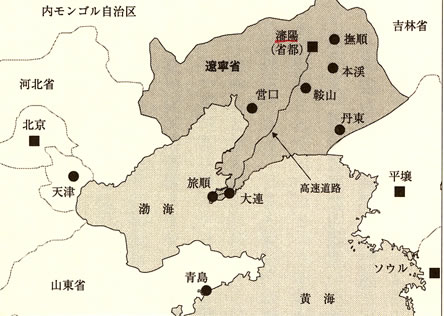 Hinterland: annual income $300
Hinterland: annual income $300
-
Dalian City: refereed to as 'North Hong Kong'
-
Financial service center.
- Hi-tech. industrial park:
Parts industry is not enough.
- Incubation policy for returning engineers
- Closeness to Japan: 70,000 speakers of Japanese
- Closeness to Korea: many speakers of Korean
- Back-office services: Pattern after Ireland:
- Database input
- Call center operation
- Debt collection
- Settlement of company expenses
- Marketing or trading function for Chinese market.
- Shenyang:
- NEUSoft Group: NEU=North Eastern University
- Alpine: software for Car navigation system
5.東北三省:
- 東北三省=遼寧省、吉林省、黒竜江省
- 省都:瀋陽 (遼)、長春 (吉)、ハルビン (黒)
- 大連:クリーンシティ
1.2万社の外国資本の内4千社は日本企業
- 後背地:所得$300/年レベル
- 大連:北の香港と呼ばれる。
- 金融サービスの拠点
- ハイテクパーク:高新技術宇産業園区
部品産業は十分ではない
- 帰国留学生の起業インキュベーション
- 日本との関係:7万人が日本語を話す
- 間接業務サービス:アイルランドが手本
- データベース入力
- コールセンター
- 債権回収
- 会社費用精算
- 瀋陽:
- NEUSoft Group (東軟集団)
NEU = North Eastern Univ.
(東北大学)
- アルパイン:
カーナビソフトウェア
>Top
6. Greater China:
- Greater China - "United State of China":
Comparison with other Asian countries except Japan.
- HK and Taiwan are China.
- 80% of Singapore are Chinese abroad.
- Indonesia, Malaysia and Thai are economically controlled by Chinese
abroad.
- Economical growth of 6 Chinese mega-regions are about 20% p.a.,
while other Asian regions' growth are several %. Korea's GDP will
be overtaken by Zhanjiang delta not-so-distant future.
- Q: Till when does China continue to grow?
- A: Maybe at least 10 years.
- Because, labor cost increase only 30% during the last decade
in terms of US$.
- While Japanese labor cost increased 30% only in a year during
1972-73.
- US$ pegged RMB is stable.
- About 10M people inflowed from farming villages during the last
decade. The hinterland has 900M population.
- But after another decade, one bomb will explode: a reaction of
'one-child policy.'
- After 2008, the year of Olympic games, China will start aging
society.
- Negative example is Japan: decline of a prosperous but bloated
country.
Comparison of economic scale among Asian countries
and Chinese megaregions:
Populatn
(M)
GDP
($B)
GDP/cap
($K)
Indonesia
212
164
0.7
Zhanjiang
138
234
1.7
長江
NE 3Prov.
107
119
1.1
東北三章
Beijing-T
91
112
1.2
北京天津
Shandong
91
104
1.1
山東半島
Zhujiang
86
116
1.3
珠江
Vietnam
80
32
0.4
Philippines
76
74
1.0
Thai
61
127
1.9
Korea
47
457
9.7
Fujian
35
48
1.4
福建省
Malaysia
22
95
4.0
Taiwan
22
310
13.8
台湾
HK
7
163
23.6
香港
SPR
4
97
26.8
Aggregated market value of major Asian stock exchanges: ($B as of
Dec.2001)
Tokyo
2265
China*
525
HK
506
Taiwan
293
Korea
194
Malaysia
119
SPR
116
Thai
36
Indonesia
23
Philippines
21
* China = Shanghai+Xinzhen 6.グレーターチャイナ:
-
<左表>アジア諸国と中国メガリーションの
経済規模比較:
- 人口 (M人)、GDP ($B)、一人当たりGDP ($K):
- グレーター・チャイナ、中華連邦
- 香港と台湾は中国である。
- シンガポールの80%は華僑である。
- インドネシア、マレーシア、タイは経済的には華僑が支配している。
- 中国6メガリージョンの経済成長は年約20%、他のアジア諸国は数%である。
- 韓国のGDPが長江デルタによって追い抜かれるのはさほど遠くない。
- Q:中国はいつまで成長が続くか?
- A: 少なくとも10年間
- 理由は、過去10年間に人件費は30%しか上昇していない。
- 日本は1972-73の1年間だけで人件費は30%上昇した。
- 米国ドル固定の人民元は安定
- 過去10年間に農村地帯からの流入した人口は約10M人。後背地の人口は9億人もいる。
- しかし10年後、一つの爆弾が破裂する。一人っ子政策の反動である。
- 2008年オリンピック以降、中国は高齢社会が始まる。
- 反面教師は日本:繁栄したが慢心した国の衰退
>Top 7. Chinese economy swallows Asia:
- Remain in the short list:
- Invite foreign capital with latest technology.
- Mayor = Division manager
- Attractive factors:
- good & cheap labor
- good management staff
- parts supply
- government friendliness
- unique features
- telling expression
- Rise of labor cost:
- 30% during the last decade
$70-80/mo (10years ago)
now $90-120/mo (now)
- Japan: 30% up/1972-73 only
- US$ peg policy
- mild inflow of population from rural areas
due to unique census registration
- 10M inflow/last decade
- Reaction of 'one-child policy'
- men & women ration: too many men
- rapid decline and aging
- loss of hungriness
7.アジアを飲み込む中国経済:
- ショートリストに残れ:
- 最新技術をもつ外資導入を図れ
- 市長=事業部長
- 魅力の要素:
- 良質安価な労働力
- 良いマネジメントスタッフ
- 部品供給
- 政府のフレドリネス
- 個性的な特徴
- 殺し文句
- 労働コスト上昇:
- 過去10年に30%上昇
$70-80/月 (十年前)
$90-120/月 (現在)
- 日本は1972-73の1年間で30%上昇
- 米ドルリンク
- 農村部からの緩慢な人口流入 (戸籍制度を利用)
- 1000万人流入/過去十年
- 一人っ子政策の反動:
- 男女比率:男が多い
- 急激な衰退と老化
- ハングリー精神の喪失
>Top 8. Future of Chinese
political system:
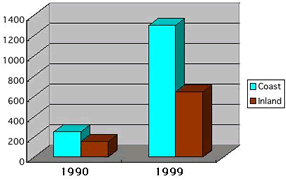 Economic disparity:
Economic disparity:
- GDP per capita of Chinese coastal areas and inland areas
- RMB8.3 = US$1
- Inland areas:
- 3 cities: Beijing, Tianjin, Shanghai
- 7 sheng: Hebei, Liaoning, Jiangsu, Zhejiang, Fujian,
Guangdong, Hainan
- Higher degree of satisfaction of inland area:
- Net increase from $150 to $640
- Relative increase of economic indicator is important.
- Leading wealth policy
- Cf: "The poor should east barley." (Hayato Ikeda)
- Federal system:
- Federal power in crisis, but local autonomy in peace.
- ambivalence between flexible economic activity and rigid political
stance just like US.
- Geopolitical approach of EU to China.
- Possibility of third Kuomintang-Communist cooperation:
The next step of one-country-and-two-systems.
- 80th anniversary of CCP in 2001:
CCP represents the following three points:
- advanced production capacity: modernization, industrialization
and scientific development
- advanced culture, global peace, and global environment.
- all Chinese people including capitalists: approved capitalist
to join CCP.
- Advent of "Federal Republic of Greater China", including
Hong Kong, Taiwan, and possibly Singapore.
8.中国政治体制の行方:
- 経済格差:
- 沿岸部と内陸部との一人当たりGDPの比較
- RMB 8.3 = US$1
- 沿岸部:
- 3市;北京、天津、上海
- 7省:河北、遼寧、江蘇,浙江、福建、広東、海南
- 内陸部でも高い満足度:
- $150から$640へ上昇
- 経済指標の相対的増加が重要
- 「先富起来」政策
- Cf: 貧乏人は麦飯を食え (池田勇人)
- 連邦制度:
- 危機の時は連邦の力、平時は地方自治
- 米国に似て、融通無碍の経済活動と硬直的な政治的立場
- EUの中国に対する地政学的な接近
- 第三次国共合作の可能性:
一国二制度の次の段階
- 中国共産党80周年(2001):
「三つの代表」理論:
- 先進的な生産力:近代化、工業化、科学の進歩
- 先進的な文化、地球平和、地球環境
- すべての中国国民の代表:資本家の入党を認める
- グレーター中国連邦国家の出現:香港、台湾、そしてシンガポールも含むかも
>Top 9. Future of China-Japan
relationship:
- Japan is the #1 trading partner of China:
- Import from Japan: #1
- Export to Japan: #3
- Less positive image of Japan:
Chinese people underestimate such facts of Japan:
- as a major power, as a major financial exporter, and as an
indispensable partner of Chinese growth.
- Tumble down to 10% country:
- Since 1998 Greater China virtually appears:
just like appearance of US a century ago in the world history.
- Japan will be getting one of the neighboring countries, which
will be 10% country like Canada to US, Denmark or Austria to Germany,
or Finland to former USSR.
- Chinese population is 1.2 billion, while Japan is 120 million.
If per capita GDP becomes equal, Japan is sure to be 10% country.
- Korean population is 40 million, which is 1/3 of Japan. 1/3
country is more influential than 10% country.
- Japan has no strategy to stop such trend. Because Chinese megaregions
are developing separately.
- Japan is almost only major centralized country.
- In borderless economy, it requires enormous energy to retain
centralized system. Japan controls its locals by way of money,
not by military power.
- Japan does not induce money from the world, but from the next
generation: government bond, municipal bond, hidden debt of government-affiliated
corporations.
- Centralized system can not conform with 21C networked society.
9.日中関係の行方:
- 日本は中国にとって最大の貿易相手国:
- 日本からの輸入:1位
- 日本への輸出:3位
- 日本に関するプラスイメージが少ない。
中国人は日本に対し、以下を過小評価
- 日本は大国、主要な資本輸出国、中国の成長に欠かせないパートナー
- 10%国家への転落:
- 1998年以降、中華連邦が事実上登場
(100年前の米国の世界史への登場と同様)
- 日本は周辺国の一つになるだろう。米国に対するカナダ、ドイツに対するデンマークやオーストリア、あるいは旧ソ連に対するフィンランド
- 中国の人口は12億人、日本は1.2億人。もし一人当たりGDPが同じになると、日本は確かに10%国家になる。
- 韓国の人口は40百万で、日本の1/3である。1/3国家は10%国家より影響力がある。
- 日本にはこの傾向を止める方策はない。なぜなら中国のメガリージョンは個別に発展しているから
- 日本はほとんど唯一の主要な中央集権国家:
- ボーダレス経済では、中央集権を維持するのは莫大なエネルギーを要する。日本は地方を軍事力ではなく、金の力で支配してきた。
- 日本は金を世界からではなく、子孫から導入している。即ち、国債、地方債、特殊法人の隠れ負債である。
- 中央集権は、21世紀のネットワーク社会には適応できない。
>Top 10. Trumps of Japan:
- Strategic regionalism:
- Make "United States of Japan."
- 11 states: Hokkaido, Tohoku, Hokuriku, Kanto, Tokyo Metropolitan,
Chubu, Kansai, Chugoku, Shikoku, Kyushu, Okinawa
- Regional coupling:
Establish interdependent relationship between both regions.
Interdependence means pain-sensitive relationship if it breaks.
- Case: Singapore deals only with Guangzhou, Suzhou, and Wuxi.
Many Singaporean are from Guangdong Sheng.
- Inter terms of economy, most of Japanese regions are bigger
than Chinese megaregions: Economy of Shanghai area is still smaller
than that of Korea or Kyushu area. Economy of Kansai area
is bigger than that of Canada.
- Toyama Prefecture goes around with Liaoning Sheng. Taiwan does
with Fujian Sheng.
- EAU - East Asian Union concept:
- EU was established spending 30 years from the Rome Treaty in
1957 to the Maastricht Treaty in 1993 and introduction of EURO
in 2002.
- Stereotyped French will not hit on or tease stereotyped German
no more.
- Three states of Lombardia of Italy is affluent like Germany
or Switzerland
- South Korea has 3 megaregions, and North Korea will have 2 megaregions.
- Stop the proliferate politics in Japan:
- 'Balanced Development Policy of National Territory' will be
Japan's tragedy; which means sinking Japan hand-in-hand, losing
dynamism totally.
- Regional strong and intensive features will appeal to world
capital (money, technology and people); being able to remain in
the short candidate list.
- 'Nothing' in rural area can be a resource of tourism.
10.日本の切り札:
- 地域国家戦略:
- 日本道州連邦を作れ
- 11の道州:北海道、東北、北陸、関東、東京首都圏、中部、関西、中国、四国、九州、沖縄
- 地域同士のカップリング:
双方の地域間の相互依存体制を確立せよ。相互依存とはそれが壊れると痛みを感じる関係である。
- ケース:シンガポールは広州、蘇州、無錫とだけ付き合っている。シンガポールの華僑は広東省出身が多い。
- 日本の地方は経済的には中国のメガリージョンより大きい。上海地域の経済は、韓国や九州よりまだ小さい。
- アジアのEU化:
- EUは30年かけて1957年のローマ条約から1993年のマーストリヒト条約および2002年のEURO導入によって創設された。
- ステレオタイプのフランス人はもはステレオタイプのドイツ人を攻撃したりからかったりしない。
- イタリーのロンバルディアの3州はドイツやスイスと変わらない生活レベルである。
- 韓国は3メガリージョン、北朝鮮も2メガリージョンとなろう。
- 日本のばらまき政策をやめよ:
- 均衡ある国土の発展政策は日本の悲劇となろう。それは全体として活力を失い、手を携えて沈没することを意味する。
- 地域の強烈な特徴は世界資本 (金・技術・人) にアピールし、候補のショートリストに残ることが可能
- 地方では、何もないことが観光資源になり得る。
>Top 11. Choice of Japanese
economy:
- Competition between Japanese companies:
Japanese competitors are exporters of Japanese capital in China.
- Sanyo, Sharp, Sony, and Japanese Sogoshosha
- It is not always bad of hollowing out of Japanese industry:
- History teaches that there is no country which declined by
de-industrialization.
- Foreign production ration of Japan is about 12%, while Germany
and US are around 30%. But chemical, pharmaceutical, and automobile
industries of Germany are sure to belong winning group.
- Hollowing out of industry means that there are still active
corporations which aim to survive in overseas.
- Japanese sericulture and silk fabrics have been protected,
and never tried to shift to overseas and persisted to stay in
Japan and perished. Rice production will follow the same scenario.
- Government should rather give incentives to corporations which
aims to expand overseas operations, because they will not require
government relief, but pursue their survival in overseas.
- Keynesians said a century ago that manufacturing industry is an
employment. But now its ratio is less than 20%, while service industry
is about 70%, and agriculture is only 4%.
- Functions of headquarter, marketing, and human resource training
still remain onshore. Educational facility prospers there.
- Misleading by media:
Journalist and academian who are almost out-of-touch global
situation advocate: countermeasures to de-industrialization,
prevention of deflation, measures against unemployment, invocation
of safeguard, etc.
- Closing: Let's make the China Impact as dynamics
of reforming.
11.日本経済の取るべき道:
- 日本企業間の競争:
日本の競合相手は、中国での日系の輸出者:
- サンヨー、シャープ、ソニー、日本の商社
- 日本の産業の空洞化は必ずしも悪くない。
- 産業の空洞化で衰退した国は歴史上存在しない。
- 日本の海外生産比率は約12%、一方、ドイツ・米国は約30%である。しかしドイツの化学、医薬、自動車産業は明らかに勝ち組である。
- 産業の空洞化とは、海外で生き延びようとする元気な企業がまだあることを意味する。
- 日本の養蚕や絹織物は保護されてきて、海外へ移転しようとはせずに日本に留まり、そして滅んだ。米の生産も同じシナリオとなろう。
- 海外進出を図る企業には政府はむしろ奨励すべきである。なぜならその企業は政府の救済を要求せずに、自らの生存地を海外を求めるのだから
- 100年前のケインズ経済学者は、製造業は雇用であると言った。現在、その比率は20%以下であり、一方、サービス産業は約70%であり、農業は4%しかない。
- 本社、マーケティング、人材育成の機能は国内に残る。そこでは教育機関は栄える。
- メディアによるミスリード:
海外事情に疎いジャーナリストや学者は、空洞化対策、デフレ阻止、失業対策、セーフガード発動を主張する。
- 結論:チャイナ・インパクトを変革の原動力にせよ。
Comment
- Ohmae's unique opinion bursts here about the China Impact to Japan.
It is interesting and hitting the nail on the head.
- This is written in 2002, but its contents are still flesh and
useful even now (2005).
- 大前研一による日本へのチャイナ・インパクトに関するユニークな意見が炸裂している。おもしろいし正鵠を得ている。
- この本は2002年に書かれたが、その中身は2005年の今日でも以前新鮮かつ有用である。
Title |
The China Impact |
チャイナ・インパクト |
|---|---|---|
Published |
2002 |
2002年 |
Index |
|
|
Why? |
|
|
>Top 0. Prologue:
|
0.プロローグ:
|
>Top 1. Birth of New China:
|
1.新しい中国の誕生:
|
>Top 2. Competitive edges of China:
|
2.中国の競争力:
|
>Top 3. Two major Chinese silicon valleys:
|
3.二大IT産業集積地:
|
>Top 4. Newly emerging regions:
|
4.発展著しい新興地域:
|
>Top
5. North-East three provinces:
|
5.東北三省:
|
>Top
6. Greater China:
|
Comparison of economic scale among Asian countries and Chinese megaregions:
Aggregated market value of major Asian stock exchanges: ($B as of Dec.2001)
* China = Shanghai+Xinzhen |
6.グレーターチャイナ:
|
>Top 7. Chinese economy swallows Asia:
|
7.アジアを飲み込む中国経済:
|
>Top 8. Future of Chinese political system:
|
8.中国政治体制の行方:
|
>Top 9. Future of China-Japan relationship:
|
9.日中関係の行方:
|
>Top 10. Trumps of Japan:
|
10.日本の切り札:
|
>Top 11. Choice of Japanese economy:
|
11.日本経済の取るべき道:
|
Comment |
|
|